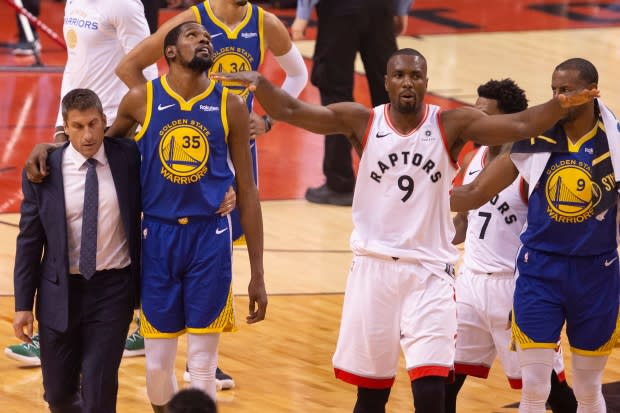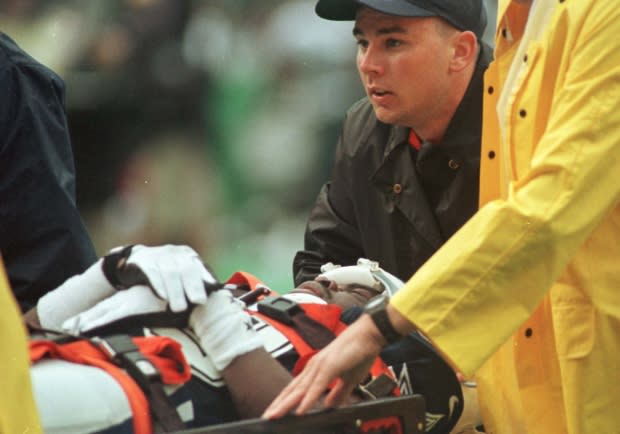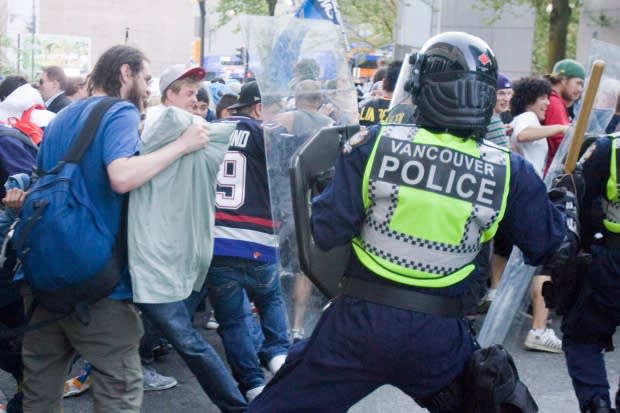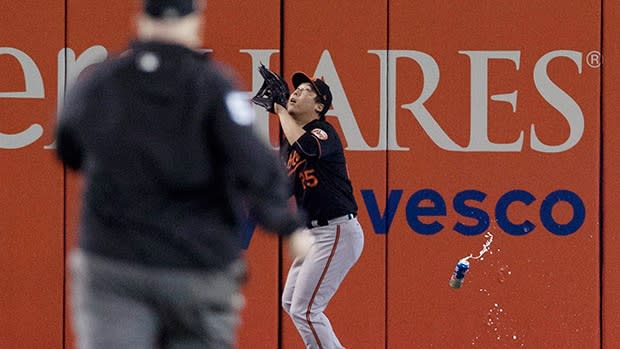Cheering of Durant injury just another example of 'classless' fan behaviour
The Toronto Raptors fans who cheered at the sight of Golden State Warriors star Kevin Durant going down with a serious leg injury in Game 5 of the NBA Finals on Monday night are being widely condemned by players from both teams, other athletes, and by people all over the world on social media.
Durant, who was making a heroic return to action after being sidelined for weeks with a sore calf, had to leave the game in the second quarter after injuring his Achilles.
The limping superstar's inability to continue playing initially prompted cheers from some fans inside Toronto's Scotiabank Arena and those who were huddled outside watching the game on the big screen at Jurassic Park, all desperate for one more Raptor win to secure the championship.
"That's crazy. That's crazy," Golden State forward Draymond Green said of the crowd's initial response. "Come on ... that's classless. For me, I've always witnessed Canadians being the nicest people that I've ever encountered."
With some prompting from Raptors players like Kyle Lowry and Serge Ibaka, the fans' contemptible cheers turned to chants of support for Durant. However, the initial reaction seems to have left the more lasting impression.
But this is certainly not the first time that spectators — even the "nicest people" like Canadian sports fans — have exhibited poor behaviour. And it likely won't be the last.
Here are some examples of the lesser moments in professional sports fandom.
Cheering injuries
The sight of an injured athlete is, in theory, a moment when all fans, regardless of the jersey they're sporting, should take the time to express concern and best wishes for the downed player. But that's not always the case.
One of the most notorious celebrations came on Oct. 10, 1999, when Philadelphia Eagles fans cheered after Dallas Cowboys receiver Michael Irvin sustained what would be a career-ending spinal cord injury. Some fans reportedly cheered as he was being led away on a stretcher.

However, years later, Irvin said he took the crowd reaction as a compliment. He said it showed that the Philadelphia fans were just concerned that his abilities as a football player were hurting their team.
"Philly wasn't cheering my injury. They were cheering my departure."
Some fans have even cheered an injury to one of their own players, apparently for the same reason.
On Oct. 7, 2012, some Kansas City Chiefs fans, unhappy with the performance of their own quarterback, Matt Cassel, applauded when he was forced to leave a game against the Baltimore Ravens after suffering a head injury.
Riots
Though not common, violence related to high-stakes sports events isn't unheard of. One of the more notorious riots happened in June 2011 in downtown Vancouver after the Canucks final Stanley Cup loss to the Boston Bruins. Riot police fired tear gas, pepper spray and flash bombs to try to disperse angry rioters who set cars on fire, looted stores and taunted police officers, CBC News reported at the time.

Vancouver police would later launch one of the largest investigations in Canadian history, with the aim of identifying and charging hundreds of people who participated in the mass vandalism and looting, CBC News reported.
The infamous beer can toss
While spectators sometimes behave poorly as a large group, there are cases where the behaviour of a single fan attracts widespread scorn.
During the wild card playoff game in Toronto between the Blue Jays and Baltimore Orioles on Oct. 4, 2016, Kenneth Pagan threw a beer can onto the field, narrowly missing Orioles outfielder Hyun Soo Kim.

Pagan would apologize, blaming the act in part on a combination of giddy impulse and alcohol. He pleaded guilty to mischief under $5,000 on May 30, 2017, and was required to perform 100 hours of community service. During that time, he was banned from all Major League Baseball stadiums.
Racial taunts
Some fans have sunk to using racial slurs against opposing team members.
Earlier this year, a Utah Jazz fan was permanently banned from all events at Salt Lake City's Vivint Smart Home Arena after Oklahoma City Thunder point guard Russell Westbrook accused him of making racial slurs.
Last year, Washington Capitals forward Devante Smith-Pelly was the target of racist taunts from hockey fans in Chicago.
Smith-Pelly said four fans were chanting, "Basketball, basketball, basketball," not so subtly suggesting that a black player shouldn't be playing a sport featuring mostly white athletes.

In 2012, some purported fans of the Boston Bruins released a series of racist tweets targeting Washington Capitals forward Joel Ward after he scored the overtime goal to eliminate the Bruins from the playoffs.
The Bruins released a statement apologizing for the incident.
Meanwhile, in Europe, some black soccer players have been subject to fans throwing bananas at them from the stands.
Booing national anthems
The protocol in sporting events featuring U.S. and Canadian teams is that all fans rise to pay respect as both anthems are performed. But it doesn't always work out that way.
In 2002, during playoff games between the New York Islanders and Toronto Maple Leafs, some Islander fans booed the Canadian anthem.
Earlier that year, the Detroit Pistons organization issued an apology after their fans booed the Canadian anthem before a playoff game against the Toronto Raptors.
During the height of the U.S.-led Iraq War, in March 2003, some Montreal Canadiens fans attracted bad press for booing the U.S. national anthem when it was played before a game against the New York Islanders.
''It is our firm belief that this kind of behaviour has no place in the context of professional sports,'' Canadiens president Pierre Boivin said in a statement.
But it happened again in Montreal a year later, on April 11, 2004, this time as the team was to face off against the Bostin Bruins in a playoff game.
So what is it with Philadelphia?
Fair or not, the "City of Brotherly Love" has garnered the reputation of having some of the rudest sports fans. Along with the infamous cheering for Michael Irvin's injury, Philly fans have become infamous for displaying other inappropriate behaviour.
In 1983, two Eagles fans were accused of attacking Chief Zee, the Washington Redskins super fan and unofficial mascot, in a parking lot after a game.
In 2001, one fan seated behind the penalty box at a Flyers game, lunged inside to get at Toronto Maple Leafs forward Tie Domi. And during a game against the Vancouver Canucks in 2011, Flyers fans showed bad timing by booing the appearance of rival Sidney Crosby on their arena's giant screen above centre ice. The problem was the Pittsburgh Penguin superstar was appearing in an ad to fight cancer.
A couple of Eagles fans were accused last year of punching police horses during two different Eagles games. One man allegedly punched a horse after a scuffle with an officer, police said. Another man, who had been booted from the stadium for drinking too much, was accused of walking up to a police horse and punching it in the face and neck.
Watch fans in Philadelphia boo Santa Claus
But, of course, the most infamous outburst by Philly fans occurred on Dec. 15, 1968, as the Eagles were taking on the Minnesota Vikings. Different reasons are given for the fan behaviour on this particular day, but as Santa Claus made an appearance on the field during halftime, fans booed Jolly Old Saint Nick, pelting him with snowballs.

 Yahoo Sports
Yahoo Sports 